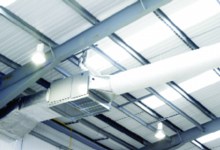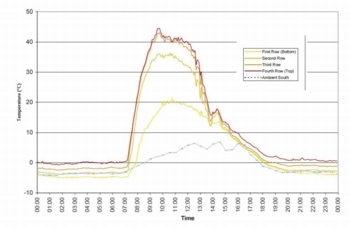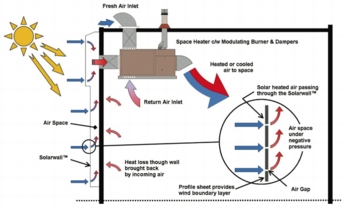Exploiting solar energy halves heating costs

AmbiRad gas-fired heater supplied by solar-heated air from a SolarWall can add more heat as required and distribute heated air via a textile duct.
An approach to using the fabric of a building to exploit renewable energy has been devised by AmbiRad Group and CA Group. It has the potential to reduce heating costs by half — and more.Imagine a sustainable heating system that enables building owners to make a genuine environmental contribution without turbines, photo-voltaic cells, or complex heat pumps. Imagine a system that provides fresh heated air for space or process heating and which can achieve payback on capital costs in as little as three years in new buildings. Imagine a system that can be completely recycled at the end of its life — making minimal ecological impact. Look no further. All those benefits are claimed for a cladding system for industrial and commercial buildings as diverse as leisure centres, retail outlets, factories and distribution warehouses, and sports halls. It captures warmth from the Sun to heat air that can then be used to heat the building. In some recorded cases, the temperature of ambient air has been raised by over 30 K — even in the UK!
Solar gain SolarWall is fitted to exterior elevations of the building envelope from south-east to south-west. It harnesses surface solar gain to pre-heat fresh air drawn into the interior through thousands of minute perforations in the cladding. In retro-fit installations the pre-heated air is usually distributed by a ventilation unit complete with modulating dampers serving perforated ducting.
 |
The air inside a SolarWall reaches useful temperatures for space heating very quickly. These graphs are for 2 March 2006. |
For new buildings a SolarWall installation can be integrated with AmbiRad Group air-heating systems to suit a wide variety of applications. On a clear sunny day, it may be possible for SolarWall to generate sufficient heat to warm the entire building. On cloudy days, it will still provide pre-heated air to the heating system — although additional energy may be required to achieve comfort conditions. Since the solar heat is collected on the wall of the building, the system benefits from the lower angle of the Sun during Autumn, Winter and Spring. In summer, SolarWall provides the additional benefit of solar shading on the southerly aspects — thereby reducing unwanted heat gains and the need for additional ventilation or cooling. The result is year-round comfort with dramatically reduced energy bills and carbon footprint. Warmth is distributed very effectively, air quality is improved and a significant proportion of heating is free. Since there are little or no maintenance costs associated with the SolarWall, life-cycle costs are extremely favourable compared with other renewable-energy systems. The technology behind SolarWall was first developed in the 1970s. Following extensive testing by the US Department of Energy, it has been in commercial production in Canada for over 15 years, where the world’s largest SolarWall was installed for Bombardier Canadair in Quebec. The 8826 m2 SolarWall resulted in energy savings of almost £97 000 per annum with a payback of 1.7 years on the incremental costs. SolarWall™ has recently been brought to the UK by sole distributors CA Group, one of the country’s leading industrial and commercial metal roofing, cladding and gutter manufacturers. The cladding is made from aluminium or Colorcoat precoated steel from Corus. The panels typically incorporate 2500 small perforations per square metre. The darker the colour, the more effective the solar absorption. The cladding is installed on exterior elevations using specially designed spacers to create a 100 to 300 mm cavity. Solar-heated air is drawn through the perforations and fed into the air cavity, from where it is introduced into an AmbiRad fully integrated heating system or into a fan if there is already a heating system. Distribution of the warmed air is designed to recover hot air that has risen to the ceiling and would otherwise be wasted, further reducing fuel consumption. The controlled introduction of solar-heated air into the building eliminates random infiltration caused by internal negative pressure, eliminating the associated cold draughts.
Independent testing To verify the performance of the SolarWall system within the UK climate, CA Group installed two systems on two of its own buildings — one existing and one new building. Before the retrofit project, CA Group commissioned BSRIA to carry out independent testing of their existing building. BSRIA conducted an initial thermographic survey and an air-permeability test, as well as installing 16 temperature and humidity sensors internally and externally to monitor heat distribution and stratification. This data was subject to an independent analysis. Following the retrofit installation of SolarWall, the monitoring of the building continued with 32 thermocouples located within the SolarWall cavity and a pyranometer in the plane of the collector. SolarWall air temperatures and solar radiation levels were recorded and logged at 5-minute intervals. The existing building was originally heated by a single gas heating unit which was only effective at the heat delivery point and there were considerable temperature differentials across the building. The building also suffered from negative-pressure problems, aggravated by continual opening and closing of doors. The building is now noticeably warmer and has a more even distribution of heat thanks to the controlled introduction of pre-heated air and constant air circulation. The negative pressure has been eliminated. The SolarWall generates heat as soon as the Sun rises in early morning, reducing or eliminating the requirement for the gas heating which would otherwise have been used.
Emissions savings In the 12 months since SolarWall was installed, heating costs for heating have been halved, amounting to around 250 MWh and 48 t of carbon dioxide. By integrating SolarWall with AmbiRad warm-air heating in a new building, even more energy was saved. CA Group fitted the cladding to a brand new 3500 m2 extension to its production facility at Evenwood. The SolarWall was installed along the south-western and south-eastern elevations and was integrated with three gas-fired warm-air heaters to serve the whole production area via textile ducts with nozzle perforations.
 |
Air that is pre-heated by solar energy in a SolarWall can be delivered to an AmbiRad warm-air heating system as part of an integrated heating system. |
On dark winter mornings when the gas-fired heating is started at 5.30 am, the integrated control system switches the system over to use 100% re-circulated air from within the factory. As the Sun starts to rise and solar gain is detected, the controller allows pre-heated air to be introduced into the system via modulating dampers, and the gas fired burners modulate down to optimise the use of free solar heated air. When the SolarWall can generates sufficient heat to match the full building demand the gas-fired burners switch off and the building is effectively heated for free. Annual energy and carbon savings as a result of integrating the two systems within the new building are estimated to be 299 MWh and 71 t of carbon dioxide. Working alongside CA Group, a number of integrated heating options have been designed by the AmbiRad Group to suit a wide range of applications and match different design criteria and aesthetic requirements. The heating products designed for use with SolarWall are listed on Energy Technology List and eligible for 100% Enhanced Capital Allowances. Systems can be matched to applications as diverse as full heating, tempered make-up air or frost protection, in each case optimising the use of solar heated air produced by the SolarWall. SolarWall and AmbiRad heating systems work together to harness solar energy and fulfil the building’s heating needs. The SolarWall is thus fully integrated with the heating system and controlled by a single, dedicated system. Frank Staniland, sales director of AmbiRad, says, ‘AmbiRad is committed to energy efficiency, with the majority of our products listed on the Government’s Energy Technology List. Working with SolarWall, we are able to offer end-users the most radical solution on the market to their efficiency and carbon reduction drive. The potential savings are truly extraordinary.’ Aesthetically, financially and environmentally, the integration of SolarWall with AmbiRad heating has created a new force in the search for sustainability and reduced carbon footprints. For new or refurbished industrial, retail, leisure or distribution developments the systems provide an extremely simple cost effective means of Part L compliance for the inclusion of renewable technology.
For more information on this story, click here:
June 07, 69Related links:
Related articles:










